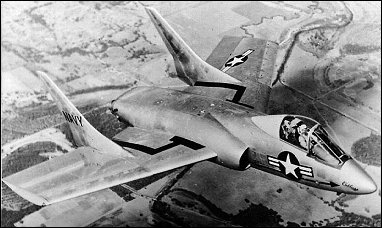 |
Vought F7U Cutlass1948 |  |
| CARRIER-BORNE FIGHTER | Virtual Aircraft Museum / USA / Vought |
 |
The Cutlass was a swept-wing tailless single-seat carrier-borne fighter which entered service with the US Navy in several versions from 1952. Production ended in December 1955. It was the first production naval aircraft to achieve supersonic flight, the first to release bombs at a speed greater than the speed of sound and the first to be catapulted from a carrier while carrying nearly 2300kg of external stores. It was also the first fighter to have incorporated in its design the use of afterburners, full power controls with an 'artificial feel' system and an automatic stabilisation system. The Cutlass wing, which was of symmetrical section, was fitted with full-span leading-edge slats, air brakes, power-operated irreversible 'ailavators' (combined ailerons and elevators) and vertical fin and rudder surfaces. Four versions were produced, beginning with 14 F7U-1 for training and operational evaluation for aircraft carrier use. Power was provided by two J34-WE-32 turbojets. The F7U-1 were followed by 180 larger F7U-3 with folding wings, arrester gear and 20.46kN J46-WE-8A turbojet engines. Armament was increased to four 20mm cannons and a new type of underfuselage rocket launcher carrying a Mighty Mouse pack. For strike missions two further packs could be carried under the wings. Delivery of production F7U-3 to the Navy began in 1954. In 1955 the F7U-3P variant was produced for photographic reconnaissance duties and 12 were subsequently completed, each featuring an elongated nose to house the camera equipment. The final version of the Cutlass (of which 98 were produced) was the F7U-3M, basically similar to the F7U-3 but with provision for carrying four Sparrow I beam-riding missiles. FACTS AND FIGURES © When the hydraulics failed a manual control system kicked in, but only after 11 seconds, during which the Cutlass went where it had last been pointed. © The long nosewheel leg put the pilot 4.5m above the ground, and a collapse invariably resulted in injury. The strut was sometimes forced into the base of the ejection seat, causing it to fire. © The J46 engines intended for the F7U-1 were not ready in time and the even lower-powered Allison J35 had to be used instead, giving marginal performance for carrier operations. © Use of the afterburners drained the central transfer tank so fast that it was possible to flame-out the engines just after take-off even though the wing tanks were full. Vought F7U Cutlass on YOUTUBE

|  COMPANY PROFILE | |||||||||||||||||||||||||||||||||||||||||||||||||||||||||
 |

|

